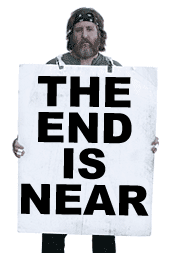
Off for a month of gallivanting around East Asia, but I am leaving a barrage of questions in my absence…
From Radical Evolution:
“Remember the comic-book superheroes of the 1930’s and 1940’s, from Superman to Wonder Woman? Most of their superpowers right now either exist or are in engineering. If you can watch a car chase in Afghanistan with a Predator, you’ve effectively got telescopic vision. If you can figure out what’s inside a cave by peering into the earth with a seismic ground pinger, you’ve got X-ray vision. Want super strength? At the University of California at Berkeley, the U.S. Army has got a prototype exoskeleton suit that allows a soldier to carry 180 pounds as if it were only 4.4 pounds. At Natick Labs in Massachusetts, the U.S. Army imagines that such an exoskeleton suit may ultimately allow soldiers to leap tall buildings with a single bound.
…[talk of pills that keep fighter pilots alert and awake for a full week, pills that numb the biological function that triggers pain (NYSE:DNA), machines that telekinetically connect monkeys to computers (OTC:CYKN), etc.]…
‘The next frontier,’ says Gregory Stock, director of the Program on Medicine, Technology and Society at the UCLA School of Medicine, ‘is our own selves.’”
Should these marvels become mainstream, what will become of the human experience?
Ruminating on the work of Marcel Proust, Alain de Botton writes:
“It is not the contented or the flowing who have left many of the profound testimonies of what it means to be alive. It seems that such knowledge has usually been the privileged preserve of, and the only blessing granted to, the violently miserable.”
 If technology succeeds in removing the concept of suffering from the human experience, what will happen to our art? Are we attracted to works created by ailing spirits through the common suffering link, and witnessing art and great literature are the closest most of us will ever come to realizing an eloquent expression of our pangs? Without suffering, will we cease to appreciate suffering? Will the work of Hirst (pill cabinets and diamond skulls) and Koons (Michael Jackson and the Hulk) then become the gold standard for ‘enhanced’ humans, while Caravaggio evolves to represent the ailing spirit of ‘natural’ human existence? Will Caravaggio’s work then warrant a stigma in a world where perfect physical specimens inhabit the earth? I wonder if we’re, to some extent, already seeing this reflected in asset valuation growth rates of contemporary art versus works characteristic of past movements.
If technology succeeds in removing the concept of suffering from the human experience, what will happen to our art? Are we attracted to works created by ailing spirits through the common suffering link, and witnessing art and great literature are the closest most of us will ever come to realizing an eloquent expression of our pangs? Without suffering, will we cease to appreciate suffering? Will the work of Hirst (pill cabinets and diamond skulls) and Koons (Michael Jackson and the Hulk) then become the gold standard for ‘enhanced’ humans, while Caravaggio evolves to represent the ailing spirit of ‘natural’ human existence? Will Caravaggio’s work then warrant a stigma in a world where perfect physical specimens inhabit the earth? I wonder if we’re, to some extent, already seeing this reflected in asset valuation growth rates of contemporary art versus works characteristic of past movements.





